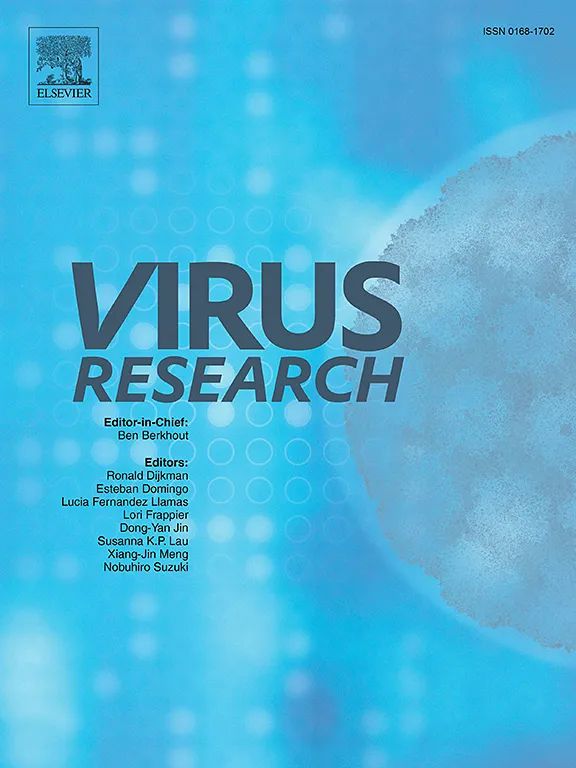Spillover of SARS-CoV-2 to domestic dogs in COVID-19–positive households: A one health surveillance study
IF 2.7
4区 医学
Q3 VIROLOGY
引用次数: 0
Abstract
The severe acute respiratory syndrome coronavirus-2 (SARS-CoV-2) is capable of infecting multiple species through human-to-animal spillover. Human to animal spillovers have been documented both in domestic and wild animal species. Due to close contact in shared households, pet dogs may be at increased risk for contracting the SARS-CoV-2 virus from infected individuals in the same household. In this study, we have analyzed serum samples from dogs (n=196) from Pennsylvania during 2021-2022 for the presence of SARS-CoV-2 specific antibodies. The dogs in this analysis included those that were exposed to individuals of the household, who had history of recent SARS-CoV-2 infection, and from dogs with no known history of potential exposure to SARS-CoV-2. Our analysis found a significantly higher seroprevalence (68 %) among the dogs with exposure to SARS-CoV-2 infection from individuals from COVID-19 positive household compared to other dogs. Our study found the overall seroprevalence of 12.24 % among dogs as determined using a surrogate virus neutralization test (sVNT). All sera that were positive by sVNT were also positive by pseudovirus neutralization test (pVNT) except for sera from one dog, likely due to a lower antibody response. The antibody titers using the panel of spike pseudoviruses in pVNT test showed higher titers against the Delta, Gamma and Alpha variants compared to Omicron. We also tested the diagnostic capabilities of a lateral flow assay (LFA) developed by Zoetis by comparing it to sVNT and pVNT. The LFA showed sensitivity and specificity of 85 % compared to sVNT and 75 % compared to the pVNT indicating its potential for field use. These findings provide serological evidence of SARS-CoV-2 spillover to pet dogs and underscore the importance of continued surveillance in companion animals as part of a One Health approach, especially as new viral variants continue to emerge.

covid -19阳性家庭中SARS-CoV-2对家狗的溢出:一项健康监测研究
严重急性呼吸综合征冠状病毒-2 (SARS-CoV-2)能够通过人-动物外溢感染多个物种。人类对动物的溢出效应在家养动物和野生动物物种中都有记录。由于共享家庭中的密切接触,宠物狗从同一家庭中的感染者那里感染SARS-CoV-2病毒的风险可能会增加。在这项研究中,我们分析了2021-2022年期间宾夕法尼亚州狗(n=196)的血清样本,以确定是否存在SARS-CoV-2特异性抗体。本分析中的狗包括那些接触过最近有SARS-CoV-2感染史的家庭成员的狗,以及没有已知潜在SARS-CoV-2接触史的狗。我们的分析发现,与其他狗相比,暴露于COVID-19阳性家庭个体的SARS-CoV-2感染的狗的血清阳性率显著高于其他狗(68%)。我们的研究发现,使用替代病毒中和试验(sVNT)确定犬的总血清阳性率为12.24%。除了一只狗的血清外,所有sVNT阳性的血清在假病毒中和试验(pVNT)中也呈阳性,可能是由于抗体反应较低。在pVNT测试中使用刺突假病毒面板的抗体滴度显示,与Omicron相比,针对Delta、Gamma和Alpha变体的抗体滴度更高。我们还测试了Zoetis开发的横向流动试验(LFA)的诊断能力,将其与sVNT和pVNT进行比较。与sVNT相比,LFA的敏感性和特异性为85%,与pVNT相比为75%,表明其具有现场应用的潜力。这些发现提供了SARS-CoV-2向宠物狗溢出的血清学证据,并强调了作为“同一个健康”方法的一部分,继续对伴侣动物进行监测的重要性,特别是在新的病毒变体不断出现的情况下。
本文章由计算机程序翻译,如有差异,请以英文原文为准。
求助全文
约1分钟内获得全文
求助全文
来源期刊

Virus research
医学-病毒学
CiteScore
9.50
自引率
2.00%
发文量
239
审稿时长
43 days
期刊介绍:
Virus Research provides a means of fast publication for original papers on fundamental research in virology. Contributions on new developments concerning virus structure, replication, pathogenesis and evolution are encouraged. These include reports describing virus morphology, the function and antigenic analysis of virus structural components, virus genome structure and expression, analysis on virus replication processes, virus evolution in connection with antiviral interventions, effects of viruses on their host cells, particularly on the immune system, and the pathogenesis of virus infections, including oncogene activation and transduction.
 求助内容:
求助内容: 应助结果提醒方式:
应助结果提醒方式:


